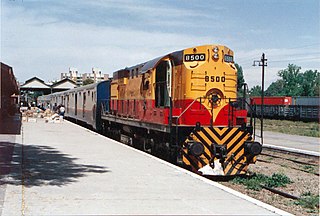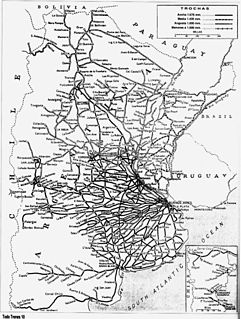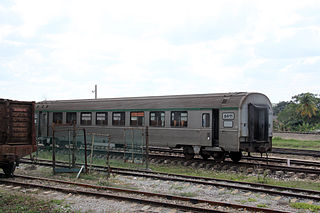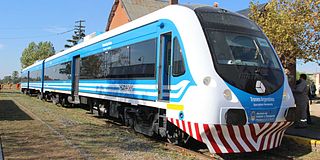Transportation in Cuba is the system of railways, roads, airports, waterways, ports and harbours in Cuba:

In rail transport, a train is a series of connected vehicles that run along a railway track and transport people or freight. The word train comes from the Old French trahiner, derived from the Latin trahere meaning "to pull, to draw". Trains are typically pulled or pushed by locomotives, though some are self-propelled, such as multiple units. Passengers and cargo are carried in railroad cars, also known as wagons. Trains are designed to a certain gauge, or distance between rails. Most trains operate on steel tracks with steel wheels, the low friction of which makes them more efficient than other forms of transport.

Ferrocarriles Argentinos (FA) was a state-owned company that managed the entire Argentine railway system for nearly 45 years. It was formed in 1948 when all the private railway companies were nationalised during Juan Perón's first presidential term, and transformed into the Empresa de Ferrocarriles del Estado Argentino (EFEA).

The M62 is a Soviet-built diesel locomotive for heavy freight trains, exported to many Eastern Bloc countries as well as to Cuba, North Korea and Mongolia. Beside the single locomotive M62 also twin versions 2M62 and three-section versions 3M62 have been built. A total number of 7164 single sections have been produced, which have been used to build 5231 single-, twin- and three-section locomotives.

The Tren Suburbano is an electric suburban rail system in Mexico City. It is operated by Ferrocarriles Suburbanos with concessioned trains from Construcciones y Auxiliar de Ferrocarriles (CAF). It was designed to complement the extensive Mexico City metro system, Latin America's largest and busiest urban rail network.

Guatemala has a network of 914 mm narrow gauge railroads, passenger and freight trains currently run.

Railroads in Honduras were built in late 19th and early 20th centuries by two competing U.S. corporations - United Fruit and Standard Fruit. All were in the Caribbean coastal area and never reached the capital. In 1993, the combined network had 785 km. At present (2006), only three separate segments remain in operation under the management of FNH - Ferrocarril Nacional de Honduras:

Rail transport in Costa Rica is primarily under the stewardship of Incofer, an autonomous institution of the state. Incofer owns the national railway infrastructure and operates virtually all freight and passenger services, which consist primarily of commuter trains through the highly populated Central Valley. The whole Incofer network is 1,067 mm narrow gauge, although there are several small tourist railways of other gauges.

The General Manuel Belgrano Railway (FCGMB), named after the Argentine politician and military leader Manuel Belgrano, is a 1,000 mmmetre gauge railway and the longest of the Argentine system. It was one of the six State-owned Argentine railway companies formed after President Juan Perón's nationalisation of the railway network in 1948.

The State Railways Administration of Uruguay, or AFE, is the autonomous agency of the Oriental Republic of Uruguay charged with rail transport and the maintenance of Uruguayan railways.

The San Martín line is a 70-kilometre (43 mi), 22-station commuter rail service in the metropolitan area of Buenos Aires, Argentina. The San Martín line operates from the city-centre terminus of Retiro north-west to Doctor Cabred in Luján Partido along a broad gauge line built by the British-owned Buenos Aires and Pacific Railway.

The Argentine railway network consisted of a 47,000 km (29,204 mi) network at the end of the Second World War and was, in its time, one of the most extensive and prosperous in the world. However, with the increase in highway construction, there followed a sharp decline in railway profitability, leading to the break-up in 1993 of Ferrocarriles Argentinos (FA), the state railroad corporation. During the period following privatisation, private and provincial railway companies were created and resurrected some of the major passenger routes that FA once operated.

The Asturias Railway Museum or Gijón Railway museum, in Gijón, Asturias, Spain, is an institution dedicated to restore, preserve and display to the public the railway history of Asturias. It was inaugurated on October 22, 1998 by the current king Felipe VI as Prince of Asturias in that moment. The centre is economically supported by Gijón City Council and it’s integrated in the museums municipal network. It’s one of the most important Spanish railways museums.

The Hershey Electric Railway, also known as the Hershey Railway, is a standard-gauge electric interurban railway that runs from Casablanca, Havana, to the city of Matanzas, approximately 92 kilometres (57 mi) to the east. There are a number of intermediate halts and a station and depot at the town of Camilo Cienfuegos, better known by its pre-revolutionary name of Hershey. The railway is the only surviving electric line in Cuba. The railway was built by The Hershey Company to transport sugar to the port of Havana. The original electric interurban cars were bought from the JG Brill Company, but these were replaced by 60-year old cars from the Ferrocarrils de la Generalitat de Catalunya in the 1990s.
Lyudinovsky Locomotive Plant is a plant in Lyudinovsky founded in 1745. In 2007 the works became part of Sinara Transport Machines.

Havana Central is the main railway terminal in Havana and the largest railway station in Cuba, is the hub of the rail system in the country. It serves for the arrival and departure of national and divisional commuter trains, and is home to the national railway company, Ferrocarriles Nacionales de Cuba (FFCC), the only intercity passenger rail transport operating in the Caribbean.

Santa Clara is the main railway station of the city of Santa Clara, seat of Villa Clara Province, Cuba. It is owned by the state company Ferrocarriles de Cuba (FFCC) and is located in front of Parque de los Mártires. It is one of the most important stations of Cuba and, along with Havana Central, Santiago and Camagüey, is a network's divisional headquarters.

The Havana Suburban Railway is a passenger rail network serving the city of Havana, capital of Cuba, and its suburbs. Owned by the national company Ferrocarriles de Cuba, it represents the only suburban rail system of the Caribbean island.

Tren Francés was the name of the flagship Cuban InterCity service between Havana and Santiago. Owned by Ferrocarriles de Cuba, it was operated by SNCF ex-Trans Europ Express (TEE) PBA coaches, originally used in Europe between Paris and Amsterdam, on the Étoile du Nord service and Mistral 69 coaches used in France between Paris and Nice on Le Mistral. Both of these two French flagship trains were replaced by TGV and Thalys from 1982 (Mistral) to 1996. The Tren Francés was formed by 12 coaches and a Chinese-built diesel locomotive.

Materfer is an Argentine manufacturer of railway and road vehicles, located in the city of Ferreyra in Córdoba Province. The company was established by Fiat Concord in the late 1950s, being its subsidiary until 1980 when Sevel Argentina took over Fiat vehicles.




































